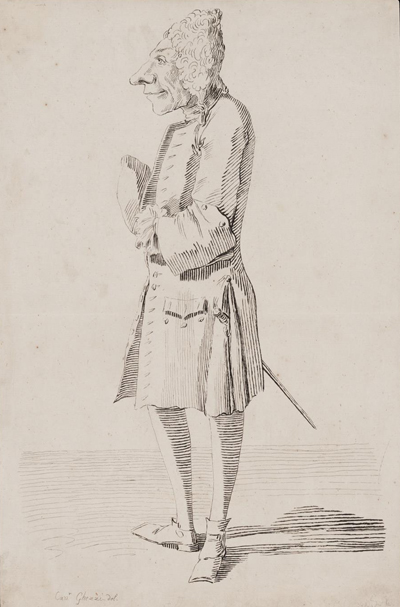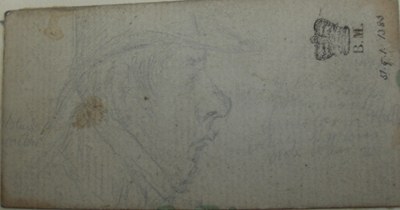Pen-Etration
This is a masterful satiric portrait of John Penn (1760 - 1834), a small time writer of critical essays, poems, and plays. It starts firmly within the portrait caricature tradition featuring a full length view of its subject in profile against a mostly blank background. The title then helps to identify or confirm the identification of Penn by a thoroughly ironic pun on his name.

© Trustees of the British Museum
But by 1799, Gillray's caricature portraits had developed far beyond the simple ironic line drawings of Pier Leone Ghezzi or the macaroni prints of Matthew and Mary Darley. The ground and background, though still fundamentally neutral, are now fully realized. The face, figure, and clothing are so much more three-dimensional, the shading so much more subtle and variable.

Dr. Thomas Bentley [1725?]
© Lewis Walpole Library, Yale University
But most importantly, unlike examples from Ghezzi and Darly, which remain ironic and definitional, Gillray's view of Penn is scathingly satiric. This is accomplished by the utterly brilliant use of the "Note" which while pretending to say what the title does NOT mean, enables us to see in the caricatured figure itself the silly goose, the stupid penguin, the socially awkward, hopelessly obtuse, Penn, often cut or ostracized, but never able to mend himself.
NB; This Title has no affinity to Pen, as connected with the Goose-Quill; nor has it any allusion to Penguin, a stupid creature between a Fish & a Fowl; - the word is simply derived from Pen, as the Instrument used to express the deep researches of the mind; see the St James's Street chitchat - respecting a Keen Pen; - a Witty Pen; - & a Pen, often Cut, but never mended.
Thanks to the preserved card in the British Museum, we can see that this portrait began with a sketch of Penn's face on one of the small cards (3 x 1-1/2 inches) Gillray used to carry around with him to capture distinctive profiles without being noticed. As in this example, Gillray would often add (virtually unreadable) notes to himself to remind him of other details on the subject's appearance and dress.

Photo by Jim Sherry*
© Trustees of the British Museum
Penn was the grandson of William Penn, the founder of Pennsylvania. Through his father, he inherited substantial land and interests in America where he lived from 1783 to 1788. As a young man of 24, he designed his own house ("The Solitude," which still stands) in what is now Fairmount Park in Philadelphia. When his lands were lost in the American Revolution, he received a lump sum of ~£85,000 from Pennsylvania in compensation for his unsold lands and another £4,000 per annum from the British Parliament as recompense for the loss. (All of which may suggest he was not as dumb as he looks.)
Returning to England in 1789, he set about rebuilding the Penn family seat at Stoke Park in Buckinghamshire, hiring James Wyatt to design the mansion and Humphrey Repton and Lancelot "Capability" Brown for the park. While his housing and landscaping plans advanced, he seems to have taken a gentlemanly interest in "worthy" causes. In the Morning Post for Saturday March 2, 1793, we find him listed as a subscriber to "The Society for the Relief of the Widows and Children of Seamen and Soldiers who may Die or be Killed in his Majesty's Service during the war." In 1796, he was among three candidates being considered for Sheriff of Buckinghamshire. In the True Briton for December 21, 1798, he is listed as a committee member of the "Society for Bettering the Condition and Increasing the Comforts of the Poor. And in the True Briton for March 22, 1799, he is listed as one of the "proprietors" meeting to discuss the founding of what was to become the Royal Society.
But it was as a writer, especially of literary works, that Penn caught Gillray's attention and one may surmise that it was the discrepancy between the intention and the actual performance of those literary efforts that aroused in Gillray such pointed satire. Here, for instance, is an ad that appeared in the London Times on January 2, 1793 that may suggest the pretensions of Penn.
In the Press and speedily will be published, dedicated to the Bishop of Worcester, Price 7s 6d in Boards. THE ART OF ENGLISH POETRY; being an Imitation of Horace's Epistula ad Pisones; in which are Allusions to almost all Artists of the first Merit in every Age and Country to which are added, the Sampson Agonistes of Milton, and the Silent Woman of Ben Jonson, reduced according to the principles of the Battle of Eddington, in ordcr to shew their effect upon works of establlished reputation. Where may he had, priced 1 6d. in boards, forming a first Volume of Works upon the same Subjects, Critical, Poetical, and Dramatic Works by JOHN PENN, Efq. Printed for Hatchard, Picadilly, and sold likewise by all the other Booksellers. Where may be had, price 7s 6d in boards, forming a first Volume of Works upon the same Subjects, Critical, Poetical, and Dramatic Works by John Penn, Esq.
The Battle of Eddington, mentioned above, was a tragedy by Penn, dedicated to William Pitt, written according to new principles to speed up the action which he supposed would revive the popularity of tragic performances. It didn't work.
Sources and Reading
- Commentary from the British Museum on Pen-Etration.
- "John Penn (writer)," Wikipedia
- Thomas Wright and R.H. Evans, Historical and Descriptive Account of the Caricatures of James Gillray #470.
- Thomas Wright and Joseph Grego, The Works of James Gillray, the Caricaturist; With the History of His Life and Times, p. 266.
Comments & Corrections
NOTE: Comments and/or corrections are always appreciated. To make that easier, I have included a form below that you can use. I promise never to share any of the info provided without your express permission.